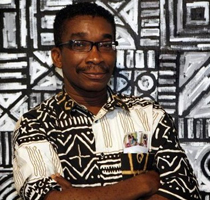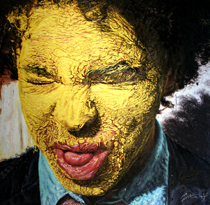The Politics of Exclusion (Part 3)
Rikki Wemega-Kwawu
Yes, there was a mass migration to the West in the 70s, 80s and 90s, mostly due to economic reasons. But interestingly the majority of creative practitioners of art stayed behind or quickly returned home, during that difficult epoch in Africa’s post-colonial history. Just a handful of African artists actually joined the exodus, understandably because contemporary African creativity was met with very poor reception in the West at the time. In the opening paragraphs of his critique of Africa 95, Enwezor vividly captures the squalor and rejection confronting the African artist/ writer in exile in the West. He prefaces his article with a melancholic quote from the late South African poet Arthur Nortje in “Waitingâ€: “[t]he isolation of exile is a gutted whore-house at the back of pleasure streets.â€
Enwezor goes on to further paint a dismal and deplorable picture of the condition of the African creative writer/artist in exile in the West. Their desperation is impotent, with many dying prematurely from the ravages of isolation. Their dreams went unfulfilled in a hostile environment unreceptive to their work because it “defied the authenticity†test, is “tainted material,†“insufficiently native†and contaminated by that virus known as “contact with the West.†With pathos, Okwui Enwezor exemplifies his points by pointing us to the exile experience of the aforementioned poet:
Reflecting his pain, Nortje`s words are charged with a plenitude of emotion, an aberrant eroticism, longings, desire and memory. The act of remembrance makes wanderers of us all, helping us build communities out of skeins of desire and nostalgia, feelings which inevitably succumb to the logic of reality. Forget it boy, your country, continent and century is gone, long gone, like the blast of a gun to the head. Your memory, just like your body, is now an occupied territory; a colonial commodity bought cheaply and sold dearly.
The question I pose to Okwui Enwezor is, how could a “gutted whore-house†yesterday overnight now be the golden theater for the playing out of contemporary Africa art? What has changed? What Enwezor wrote about Nortje in circa 1995 – the excruciating circumstances and the dire straits in which the African creative artist found himself – are clearly echoed in Olu Oguibe’s recent tribute to his friend, Esiaba Irobi.
Coincidentally, to digress a little, Olu Oguibe and Okwui Enwezor are both protagonists in the modern re-institutionalization of contemporary African Art in the West. They ensured its recognition and acceptance by the mainstream Western art establishment through a number of wonderful collaborative work, which paid off great dividends to the benefit of African art. Their efforts reached its climax with the co-authoring of the famous Reading the Contemporary: African Art, from Theory to the Marketplace. Unfortunately, however, I learnt they fell out. That is a terrible loss to African art. If they could iron whatever differences between them and get back together, it would augur positively for the growth of African art. It is a pity no attempt has been made by anybody to bring Enwezor and Oguibe together (I stand to be corrected). No matter the grievances between them, they should bury the hatchet and get back together, and get back on course, there is so much to do and there is very little time. They should not forget the African adage about the tongue and the teeth; they occupy the same space, which is, the mouth, but periodically, the teeth accidentally bites the tongue. That does not mean they reject each other. They continue to be friends, working together and occupying the same space. The import of this proverb is that, there is bound to be misunderstandings between close associates and very good friends, but that should not drive them apart.
An infinitesimally small percentage of African creative personalities may have fled into exile from their political persecutors. I know of El Salahi and Olu Oguibe himself. I am sure there were a few more others, but it is grossly erroneous for the impression to be created by Enwezor that most of Africa’s creative people and intellectuals fled to the West, while many got killed in the infernos back home. Actually, at any moment in time during the period Enwezor frames as the exodus of African artists to the West, there were more African artists on the African continent practicing their trade and craft than African artists in the West, a hundred times fold! I wager my last dollar on that.
I will refer Enwezor and any interested person to a small publication, actually, a lexicon on contemporary African art. This directory of African artists in Africa and abroad is listed by country and media. It also include names of cultural institutions and museums in Africa and in the West interested in contemporary African art, and a roster of intellectuals whose line of scholarship is contemporary African art. It was the French government’s gift to Africa to support her burgeoning art industry on the continent and the world’s growing interest in the subject. For artists in Africa in the 1980s and 1990s, it was much easier to know what was happening in the art world in Europe and America than what was happening in a neighboring African country. We did not have the Internet at that time, and mass communication was woefully poor. Communication had to be improved and facilitated among practicing African artists, home and abroad, to have exchanges and to share ideas. Hence, this motivated the French government to sponsor this lexicon. It was compiled by the French Ministry of Co-operation and Development (Ministère de la Co operation et du Développement) and the Association Dialogue entre les Cultures and edited by Nicole Guez. It was simply titled, L’Art Africain Contemporain (Guide – Contemporary African Art). The first edition was dated 1992-94, and the second edition, 1996-94.





Excellent article. While your focus seems to be visual art here, there seems to be a parallel trend in literary space. For example, most of the Nigerian writers known and celebrated globally are those in Diaspora, despite the fact that there is a thriving literary culture within the country.
I thoroughly enjoyed this piece. The discourse of home-based African art/artists versus exiled African art/artists in the 21st Century is one worth analysing.
Wemega-Kwawu has given us an insight into the world of those folks Stuart Hall (1996) described as “the deeply cultural character of the revolution of our times†(232).